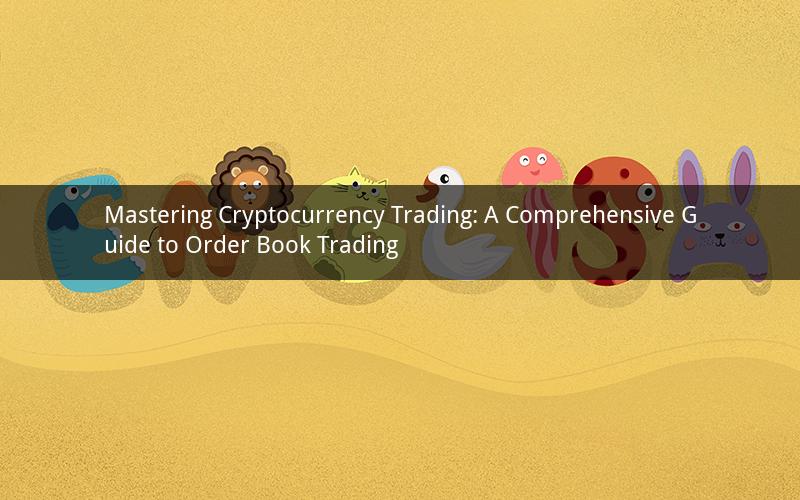
The cryptocurrency market has seen an exponential growth in recent years, attracting millions of investors worldwide. One of the key concepts in trading cryptocurrencies is understanding the order book. This article delves into the intricacies of order book trading, providing insights on how to navigate the market effectively.
Understanding the Order Book
The order book is a record of all the current open orders for a cryptocurrency. It displays two lists: buy orders and sell orders. Buy orders represent the price at which investors are willing to purchase the cryptocurrency, while sell orders represent the price at which investors are willing to sell.
Buy orders are listed in descending order, with the highest price at the top. Conversely, sell orders are listed in ascending order, with the lowest price at the top. The spread between the highest buy price and the lowest sell price is known as the bid-ask spread, which is a critical indicator of market liquidity.
Key Components of the Order Book
1. Bid Price: The highest price at which a buyer is willing to purchase the cryptocurrency.
2. Ask Price: The lowest price at which a seller is willing to sell the cryptocurrency.
3. Bid Quantity: The total quantity of the cryptocurrency that buyers are willing to purchase at the current bid price.
4. Ask Quantity: The total quantity of the cryptocurrency that sellers are willing to sell at the current ask price.
5. Market Depth: The total volume of orders at various price levels, indicating the level of market liquidity.
6. Order Size: The size of individual orders placed on the order book.
How to Trade Using the Order Book
1. Analyze Market Depth: Before placing any trade, it's essential to analyze the market depth. Look for significant levels of buy and sell orders at different price points. This will help you determine the market sentiment and potential entry and exit points.
2. Identify Entry and Exit Points: By observing the order book, you can identify potential entry and exit points. For example, if there is a high volume of buy orders at a specific price level, it may indicate a strong support zone. Conversely, if there is a high volume of sell orders at a certain price level, it may suggest a strong resistance zone.
3. Place Limit Orders: To trade using the order book, place limit orders at favorable price levels. A buy limit order will be executed when the market price reaches or exceeds the specified price, while a sell limit order will be executed when the market price falls to or below the specified price.
4. Monitor the Market: Keep an eye on the order book and market price to identify any changes in supply and demand. This will help you make informed decisions and adjust your trading strategy accordingly.
5. Manage Risks: Cryptocurrency trading involves risks. It's crucial to manage your risks by setting stop-loss orders to limit potential losses. Additionally, diversify your portfolio to mitigate risks associated with individual cryptocurrencies.
Advanced Order Book Strategies
1. Order Book Manipulation: Some traders use advanced strategies, such as sandwich orders, to manipulate the order book. By placing a large buy order above the market price and a large sell order below the market price, they create a false impression of demand or supply, leading to price manipulation.
2. Market Making: Market makers provide liquidity to the market by placing buy and sell orders at various price levels. They profit from the bid-ask spread, ensuring that there is always a buyer and seller for every trade.
3. Iceberg Orders: Iceberg orders are hidden orders that are partially visible on the order book. They can be used to execute large trades without significantly impacting the market price.
4. Order Book Analysis Tools: There are various tools and software available to help traders analyze the order book effectively. These tools provide real-time data, alerts, and visual representations of the order book, making it easier to identify trading opportunities.
5. High-Frequency Trading (HFT): High-frequency traders use sophisticated algorithms to analyze the order book and execute trades at lightning speed. This allows them to profit from small price fluctuations and market inefficiencies.
Frequently Asked Questions
1. Q: What is the difference between a market order and a limit order?
A: A market order executes the trade at the current market price, while a limit order executes the trade only when the market price reaches the specified price.
2. Q: How do I identify a strong support and resistance level?
A: Strong support and resistance levels are identified by analyzing the order book and observing where there is a significant concentration of buy and sell orders.
3. Q: Can I make money trading cryptocurrencies?
A: Yes, it is possible to make money trading cryptocurrencies, but it requires knowledge, skill, and risk management.
4. Q: What are the risks associated with trading cryptocurrencies?
A: The risks include market volatility, regulatory changes, and the potential for financial loss. It's essential to conduct thorough research and consult with a financial advisor before trading.
5. Q: How can I improve my order book trading skills?
A: Practice, study market trends, and learn from experienced traders. Utilize order book analysis tools and stay informed about the latest developments in the cryptocurrency market.